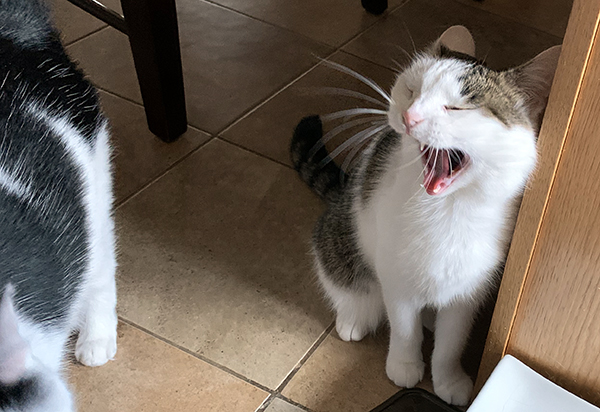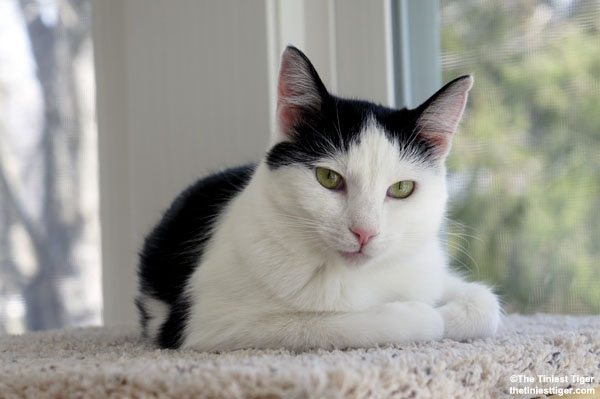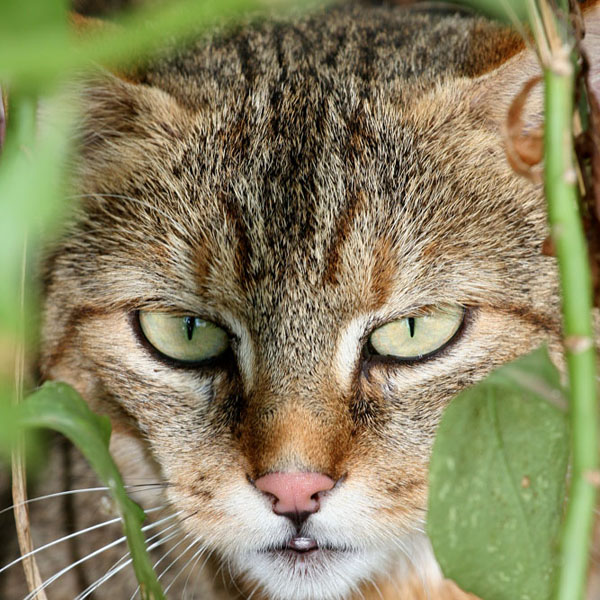The Cats Meow Also Known as the Manipulative Meow
The cat’s meow or the manipulative meow, is most common in cat-to-human vocalizations, but they are rarely observed in cat-to-cat interaction. Vocal communication plays an important role in cat-human communication, in part because vocal communication is important to the human caretakers. The meow, in particular, seems to be associated with vocal communication between domestic cats and humans. In contrast, feral cats that lack regular human contact do not display this vocalization.
Animal rescue workers have observed that the vocalization is not present in unsocialized feral cats, but only appears on regular contact with human caretakers. Although some wild felids meow as juveniles, they rarely vocalize the call in adulthood. The exception to this rule is the adult African wild cat but unlike our domestic cats, the observed wild cat meows were not directed at humans, but at the general environment.
The African Wild Cat and the connection to House Cats
Researchers have compared domestic cats’ (Felis catus) meows to those of the African wild cat (Felis silvestris lybica), their closest wild relative, to determine possible human influence. Through acoustic characteristics analysis and human listeners’ perception, it was found that domestic cat meows were shorter in duration, higher in frequency, and were perceived as more pleasant than African wild cat calls. This indicates a distinction between the species due to domestication.
In a study to test for the possibility of human influence on the meows in domestic cats, vocalizations by domestic cats (Felis catus) were compared with the cries of the African wild cat (Felis silvestris lybica), the domestic cat’s closest wild relative. The study analyzed both the acoustic characteristics and perceptual studies with human listeners. Humans were asked to rate the cat calls for pleasantness. In controlled listening conditions, and blind to the inclusion of calls from the two different cat species, human listeners judged domestic cat meows to be significantly more pleasant sounding than African wild cat calls given in comparable context.
Both the acoustic and perceptual comparisons showed clear species-level differences. The domestic cat mews were shorter in duration and a higher frequency than the wild cat meows. The humans listeners that participated in the study, regardless of their own experience and feelings for cats rated the domestic cat meows as far more pleasant sounding than the wild cat vocalizations. Domestic cats appear to meow at a higher pitch that sounds less threatening and more juvenile thus more appealing to human ears than the deeper pitched African wild cat calls.

The Power of the Manipulative Meow
Cats Use the Manipulative Meow
These results suggest that domestic cats may have adapted their vocalizations to be more appealing to humans, strengthening their persuasive abilities to get what they desire, hence the term “manipulative meow.” On the other hand, their wild counterparts have not developed this skill. This adaptation may have occurred over time as domestic cats learned which calls were most effective with their human caretakers.
Domestic cats having learned over the course of their development which of their calls appeal to humans, whereas their wild counterparts have not. These results are consistent with a theory that domestic cats have adapted their vocalization to be more pleasing to their human caretakers. A more pleasant vocal communication strengthens the cats’ ability to persuade their caretakers into giving them what they desire. Thus the use of the term the manipulative meow.
Frequently Asked Questions
Why do cats primarily use meowing to communicate with humans?
Cat vocalization as a form of communication with humans because they have learned that it is an effective way to get our attention. Over time, domestic cats have adapted their vocalizations to communicate specific needs or desires to their human caretakers.
How has the domestic cat’s meow changed through domestication?
The domestication process has led to the evolution of the cat’s meow. It has become more varied and expressive, enabling domestic cats to convey a wide range of emotions and intentions to humans. This differs from their wild counterparts who primarily use vocalizations for mating calls or territorial disputes.
Why do some cat meows resemble the cries of human infants?
Cats are known to manipulate their vocalizations, sometimes mimicking the cries of human infants to elicit a nurturing response from their caretakers. This is an example of cats adapting their communication techniques to better interact with humans.
Is there a reason cats generally do not meow at each other?
Cats usually don’t meow at each other as they tend to rely on non-verbal communication, such as body language, scent marking, and facial expressions. Meowing is specifically tailored towards human interaction.
What causes cats to make a chattering sound when they observe prey?
The chattering sound cats make when observing prey is thought to be a response to excitement or frustration. Some experts believe this sound is a mimicking of the killing bite that cats use to dispatch their prey quickly.
Can nighttime meowing behavior in cats be attributed to evolutionary traits?
Nighttime meowing in cats can be explained by their innate hunting patterns and nocturnal nature. This behavior may have been carried over from their wild ancestors, who were most active during nighttime hours. However, excessive nighttime meowing can also be a sign of a medical issue or behavioral problem that requires attention from a veterinarian or a cat behaviorist
You might also like our post: Can You Understand Your Cat’s Purrs? Listen and See.
Perceptual and Acoustic Evidence for Species-Level Differences in Meow Vocalizations by Domestic Cats (Felis catus) and African Wild Cats (felis silvestris lybica). Nicastro, Nicholas. Journal of Comparative Psychology 2004, Vol 118, No3. 287-296.


I have a few ferals that live in the house with us. We’ve had them since kittens, but they don’t interact with us, only with the other cats. Emily, one of them, meows to Tony, one of our tame cats. She won’t interact much with the other tame cats, its only Tony she is interested in. She will interact with her 2 siblings and doesn’t shun the other 2 feral cats (semi-feral actually, they can be touched) we have. Her siblings will interact with several other of the tame local residents, especially Rygel, the white eared cat in my avatar, she only seems interested in Tony.
That is interesting. Thank you for sharing.
Cashew is the loudest in our house. He really likes to let you know when he wants your attention or something else. My son has this game he’s plays with Tubby. He will pretend he’s going to get him and Tubby does a bunch of small meows and shows off and just as son is going to touch him he runs down the hall. He could play for a long time. Tubby loves this game. It’s so funny. He will only do it for him too. Garfield has the littlest meow. Charlie is a lap cat so he will talk to you so he can get you to let him sit on your lap. He also loves to talk when you pet him and he starts to wiggle.
Sue B
That sounds so fun to watch Tubby and your son play. Annie and I play hide and seek. Eddie and Mercy don’t seem too interested. Gracey loved to play hide and seek too.
My “kids” talk to me a lot, but they also talk to each other when playing — especially when chasing each other!!
That is interesting. I don’t hear Annie and Eddie talking much to each other. But if Eddie can’t find Annie he sits and lets out a high pitched cry until she finds him.
Bella doesn’t really meow she meeps. Shadow is very talkative, he has a demanding meow that sounds like NOW.
LOL. Mercy too has a louder meow than the kittens.
guys…de studee forgetted ta menshun that domestic kittehz ALWAYZ get what they want with a meowz two !! =^..^=
That is true for the most part. Maybe not always, but 99% of the time. lol